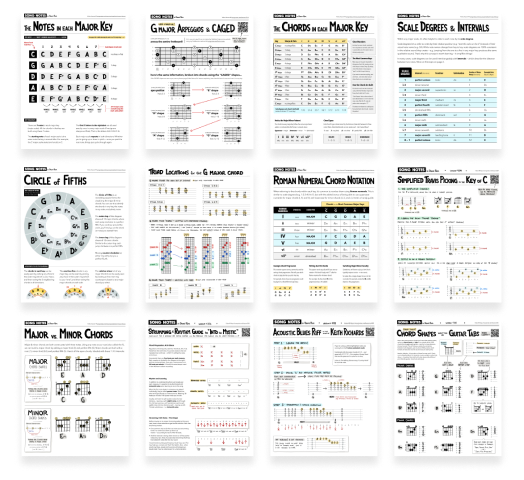Playing G major chord with only 2 fingers
Lesson #83 • Jul 14, 2017
Video Overview
Instructional PDF 1 page
Editor’s notes
In this quick practice tip, I’ll teach you how to play the G-chord using only two fingers! I’ll explain why this is easier to do than a normal G, and show you how it frees up your other fingers to play cool flourish notes. This can be used anytime you have to play a G-chord, and is something I use quite a bit. I’m excited to show it to you today.
Normal ways to play G
First, let’s review the common voicings for the G-major chord, that you’ll often see when learning guitar. Here’s the typical way the G-major chord is taught, where you have 3 left-hand fingers fretted. This can be played with these two different finger positions:
e –––3––– <== left pinky e –––3––– <== left ring or pinky
B –––0––– B –––0–––
G –––0––– G –––0–––
D –––0––– D –––0–––
A –––2––– <== left middle A –––2––– <== left index
E –––3––– <== left ring E –––3––– <== left middle
You can can play this “4 finger” version of the G major chord, which looks like this. The 3rd fret on the second string (i.e. the B string) gives us a “D” note, which is the 5th tone in the G-major scale. Without that finger, the “open” second string gives us the “B” note, which is the 3rd tone in the G-major scale. Remember, a G-major chord is simply composed of the 1-3-5 notes in the G major scale… so both of these voicings are valid ways to play G chord!
e –––3––– <== left pinky
B –––3––– <== left ring
G –––0–––
D –––0–––
A –––2––– <== left index
E –––3––– <== left middle
The 2 finger “easy” version
Here’s the easier way to play G, that I show in my video above. This only uses two fingers, and in my opinion is far easier to switch to once you get used to it. It also frees up your left middle and left index fingers for flourish notes, as I show in my video.
e –––3––– <== left pinky
B –––0–––
G –––0–––
D –––0–––
A –––x––– <== muted with left ring (lightly touch the string, don't push it down)
E –––3––– <== left ring
When to use which voicing of G?
Fortunately, I have a separate lesson explaining how you might think about “when” to use the different voicings I show above. It’s all based on context, and the other chords you’re playing. The goal is to set yourself up for easy chord switches, which I explain in this video:
Enjoy My Lessons? Show Your Support!
Most of the lessons on my website are 100% free. If you have the means, please show your support with a tip jar contribution. I put many hours into every lesson — but it only takes you a minute to make a donation. You have my thanks!
Looking for More Song Lessons?
Featured Courses
Fun & Helpful Tools I've Made
Coming soon is Jambox – which shows all the video jam tracks I've made. It's note quite ready for the spotlight, but check it out if you like!
Subscribe to my YouTube channel
Be sure to never miss a lesson by subscribing on YouTube. I put out 2-3 new videos every week. These include full song lessons, as well as covers, practice tips, behind-the-scenes updates. Thanks!
Recent Lessons
-
July 18, 2025
Minor Key Handbook – Now Available!
-
July 11, 2025
Melody & Chords, Together! ft. Leonard Cohen's "Hallelujah"
-
June 30, 2025
FretMonster Update! New Features & PDF Handbook Now Available
-
June 17, 2025
"London Homesick Blues" from Jerry Jeff Walker / Gary P. Nunn
-
June 16, 2025
[Updated] "Mr. Bojangles" by Jerry Jeff Walker
-
June 12, 2025
Father's Day Sale - 20% Off Gifted Memberhsips!
-
June 6, 2025
"Dancing in the Dark" by Bruce Springsteen
-
May 28, 2025
Beginner Guitar Course - 5 New Lessons!
-
May 15, 2025
"Centerfield" by John Fogerty


